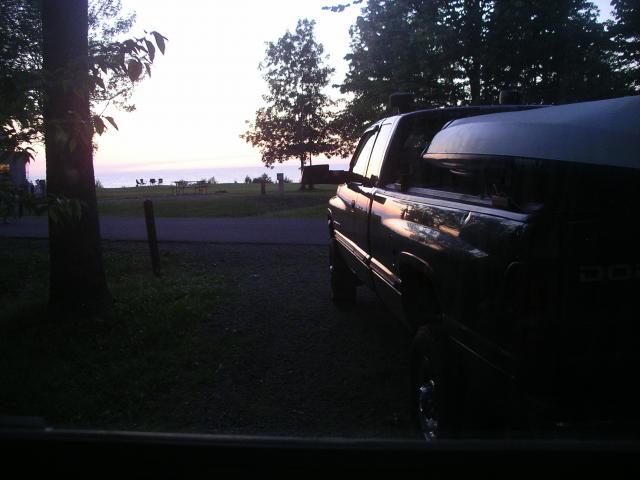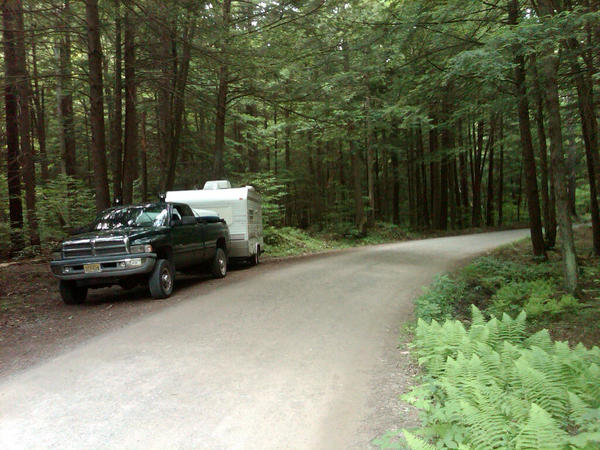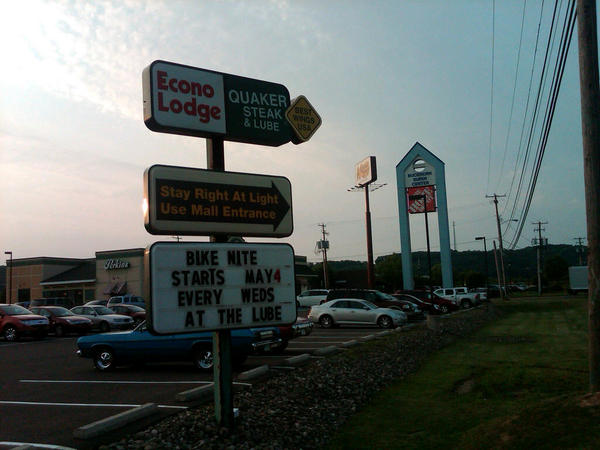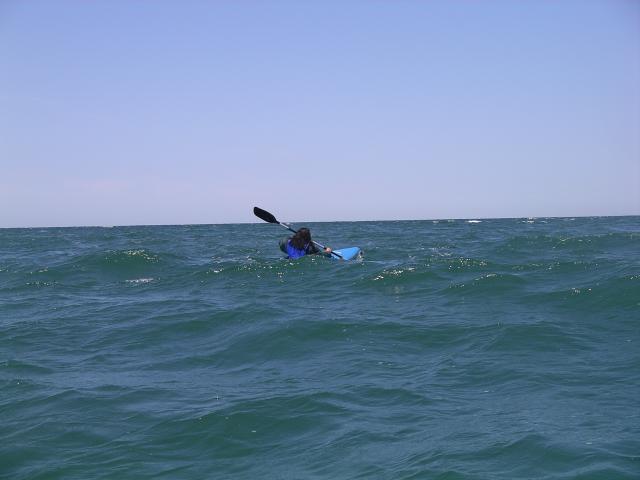- Homepage (this page)
- Tech Site
- Old Funny Site
CategoriesAdsSyndicate This Blog |
Lake Ontario, June 2011Sunday, July 3. 2011
With my typical tendency to postpone decision-making until some other time, I found myself searching for available campsites for the week prior to July 4th... with barely 3 weeks to go. We were looking to get away for 8-9 days and return on July 3rd, prior to the crazy traffic - and ideally not spend the entire week driving, leaving plenty of time to explore and enjoy one area, which would ideally be nice enough to warrant such exploration.
I settled on lake Ontario for no specific reason other than "it felt right" - and went through Reserve America one state campground at a time (using their semi-usable Microsoft-biased web interface). Most were booked solid or had availability in what appeared to be the worst remaining sites. My clockwise search around the lake eventually reached Lakeside Beach State Park, and that is where we went. The park is less crowded (except on July 4th, as I can attest) than its neighbors because it lacks a swimming beach altogether - in fact, it even lacks a boat launch. All access to the lake is either over boulders, cliffs, or both. For us, this is an ideal destination: less crowded, fewer kids, more serene. (Again, except July 4th). I was able to reserve the closest site to the lake on loop C for the days we wanted, and off we went to be quite surprised on arrival. The Sites and the GovernmentAs it turned out, while Loops A,B,C,D are by the lake, only some select sites on A and D have any access or visibility of the lake at all - the other sites (ours included) sit one swamp and forest away from the water. You do get a fairly quiet forest experience, but it's also stagnant and the soundtrack of birds is generously supported by the hum of mosquitoes. There is no sunlight at any time on these sites, and that's not quite what we had in mind. A quick stroll through the park indicated that there may be availability on loop A (the loop with the best lake views) and so the next morning we ran over to the office to ask if we could switch our site, at least for part of our stay to one of the lake-front A sites. The ladies were most helpful, but apparently they are either not fully versed in the intricacies of the reservation system (yes, Reserve America's back-end), or the system really isn't that flexible. After about a half hour of animated discussion we were told that while the best sites on A are available for 4 or 5 of the 6 days we'll be there, we can't have either because the system can only let us change the reservation for the entire remaining stay! They did however offer us two second-row sites in loop A, which are a major improvement. We switched our reservation, and then declared our intent to double-pay by also reserving the best site for 4 days, spending the 4 days there and then reverting to the next-best site we now possessed. Once again, we were denied - apparently that is also not possible because in order to reserve two concurrent sites, you must be able to occupy both concurrent sites concurrently. Our bewildered expressions did not make the ladies change their minds, and we were unable to offer any argumentation on the grounds of our inability to grab onto a single straw of common sense. Then I recalled that we're staying at a State Park, and not dealing with a free enterprise - when dealing with government, money doesn't serve a deciding role after all. And thus we spent our week at A15, which did offer a bit of a lake view.  Post-Sunset View from site A15 The CampgroundJust outside our hard-won A loop is a large neatly mowed field offering a beautiful cliff-height view of the lake. Unlike what one might expect in New Jersey, there are no barbed-wire fences to keep careless pedestrians from careening 10 feet to their certain death (in the bushes below) - in New York state a simple "Keep Back From Bank" sign is sufficient, and we are most grateful for the unspoiled views. We would go out to this field to watch the sunsets. The recreational area of the park contains a variety of dirt roads, some mowed roads (shorter grass than surrounding area but no pavement). Some of these are dedicated to a locally-popular sport of Disc Golf, which is apparently a game of sequential frisbee target-practice, much as golf is a game of sequential ball target-practice. This game involves a fair amount of walking, I'd guess that a course can be 2-3 miles long - and some of it is along the lake cliff, so poor aim in the wind can mean a loss of frisbee. The campground itself is equipped with a single 3-lane dump station, and 2 water spigots per loop. All the sites on the loops I visited had electric, some 30 and some 50 amp. The sites are comparatively spacious, and people tend to be friendly when given enough space. None of the sites are pull-through and some of the larger visitors had some trouble backing in. As always, this is a very interesting time to observe how family communication dynamic unfolds - with the "No, your other left!" being not so much a cliche but a frequently heard utterance. This is one of the reasons I have a camera on the truck and on the back of the trailer - most sites I can manage without help and even without having to get out. Water access is possible in a couple of spots in the campground, but it's not close to a paved road and carrying a kayak was somewhat tiresome, but well worth it. Which brings us to: Kite KayakingIn preparation for the trip I researched wind patterns on the lake, and it was clear that wind is frequent and predictable. Having two single sit-inside kayaks at my disposal, I decided to make one small change to the way I normally use them - adding wind power. Adding a full mast would be an involved endeavor (outriggers, reinforcement, real sail, real money), but getting pulled by a kite seemed very doable. After reading a lot of mixed opinions on kite kayaking (a lot of naysayers) I settled on going with a simple, non-controllable kite, and bought a Power Sled 14. To give the naysayers credit, there is risk involved - if you attach a kite to the kayak and you capsize, your kayak will get away from you fast, leaving you on your own to either swim to shore or, well, not (and that has happened). If you intend to hold the kite, you'd definitely need a kayak with a rudder (mine has none) as you need to steer. I got a small enough kite that I didn't feel that it would have a strong destabilizing potential (I was correct) but would have adequate pull (I was also correct, depending on wind). I made one simple modification to the kayak - added a cleat. Now I could secure the kite for hands-free operation. I am not altogether lazy, but I also don't want to overestimate my ability to paddle upstream (or upwind) - so I made it a point to go downwind only. A single-line kite can only go down wind, so the wind determined my course. I first did a short half-mile trial run, and while the trip was quite enjoyable, deploying the kite from the kayak was surprisingly difficult - in fact, I drifted my entire half mile before I managed to do it. I eventually got better - and constant wind helps. The kite is rated for 6-20mph, I'd say that with 6 you'd have to be running into the wind to launch it, which isn't something I can do in a kayak. For my real kite run, I found the next boat launch up-wind of our location - which turned out to be 12 miles west, in Golden Hill park. The winds were strong and the forecast confirmed that my plan should work - consistent west winds of 18-20mph. I got dropped off at the launch pier, paddled out to the lake, with waves over 3' high at times (not something I'm used to - I don't even have a kayak skirt), and managed to launch the kite with the first attempt - apparently at 20mph it's not so hard. In fact, holding on to the kite was more of a challenge. The direction was pretty much perfect and the trip took about 3 hours. I stayed about 1/4 mile from shore, enjoying the view of all the lake-side properties while my kayak bobbed vigorously in the waves which occasionally delivered a reawakening splash of cool water directly into my pants by way of the open pockets. I did practically no paddling the entire 3 hours - instead braking to maintain course. A GPS app on my blackberry told me that my speed varied between 4 and 7 mph - and I believe it too, my kayak was slicing water audibly. In fact, my experience was 3 hours of surfing rather than kayaking - the boat would ride the wave crests for 2-3 seconds at a time. The kite hung confidently at about 200' in the air, making a slight whistling noise that I initially mistook for displeased distant seagulls. The main complaint I had on this trip is the uncomfortable kayak seat, which I was able to rectify towards the end by grabbing a suitable piece of driftwood to act as a seat-back. Unfortunately I was unable to film or take any photos during this trip because maintaining course and keeping the boat from being splashed into submersion was a full-time occupation for both hands. I did however piece together a video from scenes filmed from the ground - see it here. Kayaking and Near Death ExperiencesAfter my successful solo kite run, I decided to share the kayaking fun with my wife, and we went out together in our singles the next day. It so happened that we just found a great restaurant (Lighthouse) about 3 miles East of the park, and right by the restaurant is a pier, wavebreak, and a boat launch. The restaurant, incidentally, serves very simple and yet surprisingly good food - the chef is an artist. The waves were somewhat more manageable (see photo above) but still considerable. In an hour, we managed to go about half mile upstream in the hopes of possibly either relaxing while drifting back to pier, or even deploying the kite. Neither happened because things didn't go according to plan. I tethered my kayak to my wife's and asked her to hold on to a small red buoy to give me some time to deploy the kite. I was severely underestimating the waves, overestimating her ability to balance, and completely overlooking the fact that I had towed her kayak upstream of the buoy and left it parallel to the waves. As she reached for it, a wave simply flipped her out of her kayak. The severity of the situation did not register for me initially but became more apparent as it became certain that she will not be able to climb back into the now severely submerged boat, and we would not be able to bail it either. I was quite glad that we are both actually wearing our life jackets, and I would be even more glad later that we actually brought our trailer with us to the pier! (Incidentally we brought it because we ran out of water and had to move it anyway to dump and refill). She gave me her now fully submerged phone (a Droid X) which was thoughtfully placed into a zip-lock bag (which was not enough to save it), and we proceeded to shore - me towing her and the sunken kayak. As I quickly learned, towing a full kayak (1000lbs of water?) and a bobbing human in a life jacket is not so easy. Even if I could go faster than practically no faster than the current, I'd dislocate her shoulders when taking up the slack on the tether in between the waves. After about 10 minutes of getting nowhere fast, I figured I'd abandon the other kayak and tow just the bobbing human, in hopes of getting the bobbing human to safety before hypothermia sets in fully - she was now unable to use many of her muscles due to cold exposure (water temperature this far out was not that warm), and she does need to hold on to my boat, which she was practically unable to do at this point. Abandoning the kayak didn't seem to yield any speed improvements but it did have a psychological benefit of "At least I'm doing what I can". Fortunately we made it back in about 40 minutes, at which point some helpful nearby humans assisted her exit from water at the first possible location (which was far from safe but better than the alternative). I hurried back to the RV to treat her condition with a hot room and a hot shower (and why did I leave the water heater turned off!), but managed to float by an outgoing power boat and ask them to retrieve our abandoned kayak should they encounter it (they did). A lukewarm shower and an 85 degree sauna which was our trailer and one cup of tea later we had a mostly-restored non-bobbing human in need of a muscle relaxants but no acute care. The human also appears to be undeterred by the experience and interested in wave kayaking in the future (perhaps with proper equipment). Crowded CampgroundBy July 1st and 2nd the campground was showing visible signs of the oncoming onslaught. Up until then the A loop was less than 50% full, but each day a few more sites would be claimed. By the time we left at 9AM on the 2nd, the last sites were being filled - and the previous night was nowhere near as peaceful as the others - complete with loud discussions, occasional fireworks, and the frequent preventative appearance by local law enforcement (first time in a week). Some of the more reverse-challenged late-night arrivals also add to the experience. In other words, this place is great on non-holiday weekdays. The trip homeWe had an extra day after our campground checkout and we planned to take a slightly longer route home and pass through Tioga State Forest, hopefully enjoy the day there, perhaps kayak, spend the night at a truck stop, spend some time in the morning at Bald Eagle and then head home. We did find Tioga, but our inexperience caused us to have inappropriate expectations - a state forest and a state park are not the same thing. Tioga has a very nice one-lane (as in, one total) dirt road that seems to go through the entire thing - complete with a drop-off to the stream below on one end and hillside on the other. The road is dry in places and the stream of dust behind us was as tall as the trailer (my poor bearings). We endured about an hour of bumpy and dusty careening and dodging potholes before exiting the State Forest - not once did we encounter anything remotely similar to a parking area. We managed to drive onto some mossy forest to stop for lunch, but that was not easy.  Tioga roadside picnic - at the widest spot After giving up on finding any accessible area to spend some time without the company of thousands of blood-consuming insects, we just went over to a truck stop (TA in Buckhorn, PA) and called it a day. This truck stop is not electrified so all the truckers are idling all night - thus we parked in the car parking lot, which was less noisy but in no way a restful place to sleep. Gas is cheaper here than anywhere so far - $3.39/gallon? Just outside the truck stop is a food establishment (I believe, anyway) with a fascinating name: Quaker Steak and Lube.  Quaker Steak and Lube In the morning we stopped by Nescopeck State Park and walked around the lake. The sun was just appearing, but the mosquitoes were already out, so we had to walk quickly - but it is quite pretty and rather serene. This is a popular dog park, it seemed. You could theoretically kayak the lake if you don't mind carrying your equipment about a 1/4 mile to the water. Even though this park is right on Route 80 and thus was on our way, getting to it required an almost 10 mile drive on a 35mph road which was paved but certainly not smooth. Trackbacks
Trackback specific URI for this entry
'Coffee Bar' design by David Cummins powered by Serendipity |






